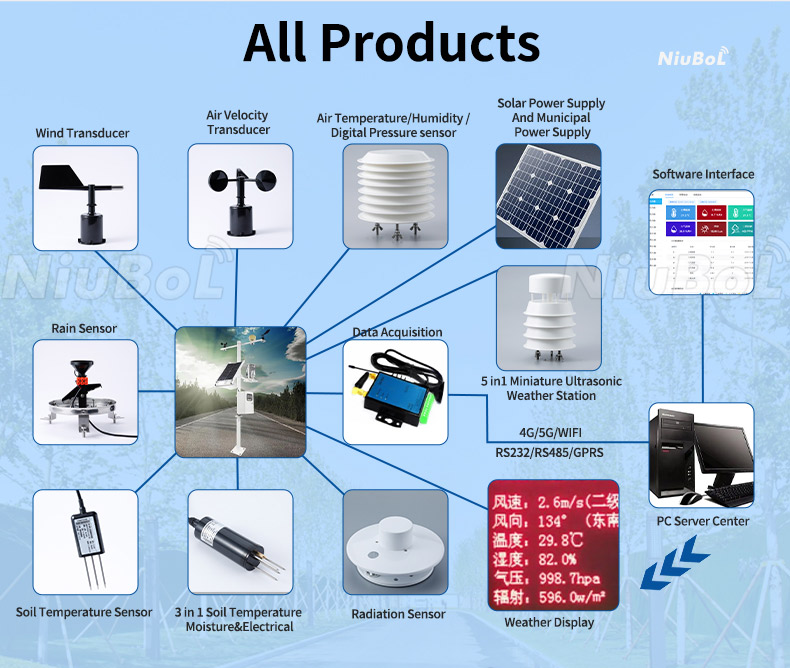

— Blogs —
—Products—
 Consumer hotline +8618073152920
Consumer hotline +8618073152920 WhatsApp:+8615367865107
Address:Room 102, District D, Houhu Industrial Park, Yuelu District, Changsha City, Hunan Province, China
Product knowledge
Time:2024-03-05 14:17:28 Popularity:2115
Weather sensors are devices that are used to measure and monitor different parameters in meteorology, and they are vital for weather forecasting, climate research, agriculture, navigation, aviation, and other fields. These sensors can measure a variety of meteorological conditions including, but not limited to, temperature, humidity, barometric pressure, wind speed, wind direction, precipitation, solar radiation intensity, and more. Here are some common types of weather sensors:
1. Temperature Sensors: used to measure the temperature of air, water or other media. Common temperature sensors include platinum resistance thermometers (PT100, PT1000), thermocouples, and semiconductor temperature sensors.
2. Humidity Sensor: Used to measure the amount of water vapor in the air, also known as the humidity of the air. Common humidity sensors include capacitive humidity sensors and resistive humidity sensors.
3. Barometric Pressure Sensor: Used to measure atmospheric pressure. Changes in barometric pressure can be used to predict changes in the weather. Commonly used barometric pressure sensors are piezoresistive and capacitive barometric pressure sensors.
4. Wind Speed and Direction Sensors: Wind speed sensors usually measure wind speed by means of a rotating cup wheel or ultrasonic technology, while wind direction sensors determine the direction of the wind by means of a wind vane.
5. Precipitation sensors: are used to measure the amount of precipitation over a given period of time. Common precipitation sensors include tipping bucket rain gauges and optical rain gauges.
6. Solar Radiation Sensor: Used to measure the intensity of solar radiation. This is important for research on climate change, solar power generation and other fields. Common solar radiation sensors include absorption radiometers and reflectance radiometers.

7. Cloud cover and cloud height sensors: used to measure the extent of cloud cover in the sky and the height of clouds. This is important for aerospace, weather forecasting and other fields.
8. Visibility sensor: Used to measure the transparency of the atmosphere, i.e. the furthest distance that can be seen under certain conditions. This is important for areas such as traffic safety, navigation and aviation.
9. Ozone concentration sensor: Used to measure the concentration of ozone in the atmosphere. This is important for monitoring levels of ultraviolet radiation and for studying changes in the ozone layer.
These sensors can be used individually or combined into weather stations to provide more comprehensive weather information. As technology advances, weather sensors are becoming more accurate and diverse, thus providing us with more knowledge about the Earth's climate system.
Weather Sensor Industry Classification
Weather sensors play a key role in several industries, and their applications can be categorized into the following major industries based on their application areas:
1. Meteorological and Climate Research: this is the most traditional and important application area for weather sensors. It is used to monitor and study weather changes, climate patterns, extreme weather events, etc., providing data support for weather forecasting and climate change research.
2. Agriculture: In precision agriculture and smart agriculture, weather sensors are used to monitor temperature, humidity, precipitation, etc., to help formulate irrigation plans, pest control, and crop planting strategies, and improve crop yield and quality.
3. Aviation industry: Weather sensors are critical to flight safety. They are used to monitor wind speed, wind direction, air pressure, visibility, etc., providing important information for flight planning and air traffic management.
4. Oceanography and Navigation: In marine research and navigation, meteorological sensors are used to monitor sea weather conditions, sea surface temperature, salinity, etc., which are important for route planning, marine resource development and marine environmental protection.
5. Environmental Monitoring: Used to monitor air quality, radiation levels, ozone concentration, etc., providing data support for environmental protection, pollution prevention and public health.
6. Energy Industry: In the field of renewable energy, especially wind and solar power, meteorological sensors are used to monitor wind speed, solar radiation, etc. to optimize energy output.
7. Transportation: Meteorological sensors are used in road, rail, shipping and urban traffic management to monitor weather conditions and improve traffic safety and efficiency.
8. Architecture and urban planning: In building design and urban planning, weather sensors can help assess the impact of weather conditions on building performance and guide the selection of building materials and energy-efficient design.
9. Tourism and outdoor activities: Weather forecasting services for the tourism industry to ensure safe and enjoyable outdoor activities.
10. Military: Weather sensors are also widely used in the military sector, including weather support in tactical planning, training and operations.
By using weather sensors to collect and analyze weather data, these industries can not only improve their operational efficiency and safety, but also promote scientific research and environmental protection. As technology develops, the range of applications for weather sensors will continue to expand.
Prev:Wind speed measuring instruments
Next:Difference between Probe Soil PH Sensor and Glass Electric Soil PH Sensor
Related recommendations
Sensors & Weather Stations Catalog
Agriculture Sensors and Weather Stations Catalog-NiuBoL.pdf
Weather Stations Catalog-NiuBoL.pdf
Related products
 Combined air temperature and relative humidity sensor
Combined air temperature and relative humidity sensor Soil Moisture Temperature sensor for irrigation
Soil Moisture Temperature sensor for irrigation Soil pH sensor RS485 soil Testing instrument soil ph meter for agriculture
Soil pH sensor RS485 soil Testing instrument soil ph meter for agriculture Wind Speed sensor Output Modbus/RS485/Analog/0-5V/4-20mA
Wind Speed sensor Output Modbus/RS485/Analog/0-5V/4-20mA Tipping bucket rain gauge for weather monitoring auto rainfall sensor RS485/Outdoor/stainless steel
Tipping bucket rain gauge for weather monitoring auto rainfall sensor RS485/Outdoor/stainless steel Pyranometer Solar Radiation Sensor 4-20mA/RS485
Pyranometer Solar Radiation Sensor 4-20mA/RS485
Screenshot, WhatsApp to identify the QR code
WhatsApp number:+8615367865107
(Click on WhatsApp to copy and add friends)
